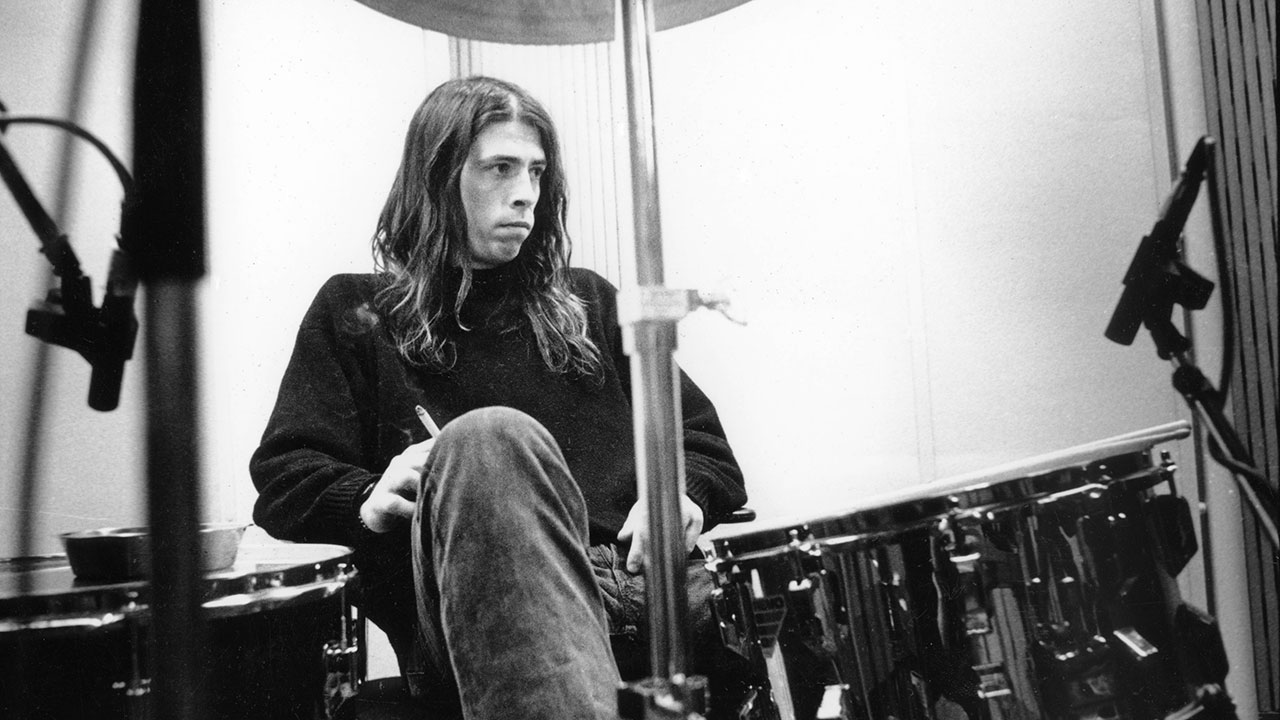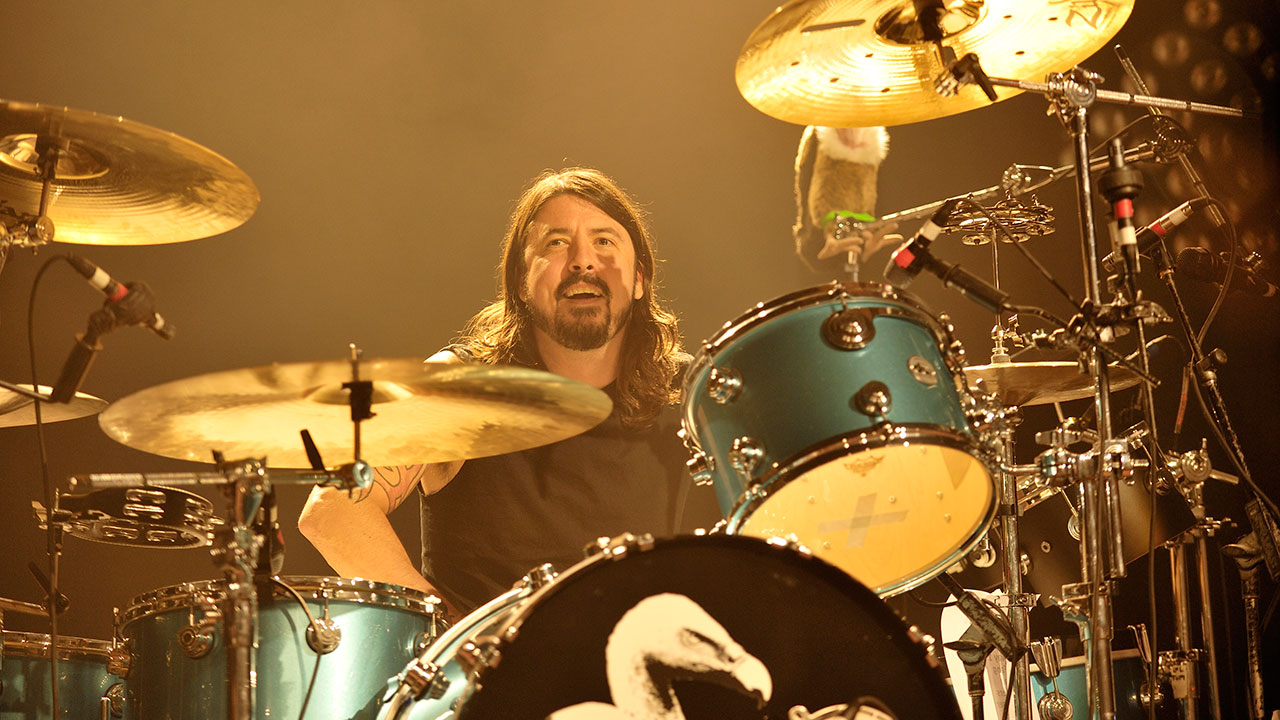Imagine you’re Taylor Hawkins. You are guided to a stool and you have to sit on it and play a drum kit behind a man responsible for some of the most crunching, ferocious and downright seminal drum riffs, rolls and rhythms the rock world has known. A guy dubbed by Josh Homme, “the greatest drummer in the world”, and one regularly labelled the hardest working man in showbusiness, Dave Grohl.
You’d be nervous… right?
Grohl’s prowess behind the kit is well documented, right back to his hardcore origins in Washington DC’s Scream. So impressed were Kurt Cobain and Krist Novoselic after seeing just one performance by the proto-emo noisemongers that they made it known to friends that night that they were keen on poaching Grohl for their band. Nirvana, pre-Grohl, had been through a run of fair-to-middling stop-gap drummers and were far from the exception to the emerging grunge rule. The kit sounds on Bleach are, at best, mechanical and often stereotypically redneckish in tone. That’s not to say Dave Grohl was Nirvana’s saving grace (although it is a convincing argument). But from the moment he plonked himself behind Nirvana’s kit, a surge of power – one often so forceful that a roadie had to sit in front of the bass drum to stop it moving forward – was unleashed that underpinned the trademark Cobain sound as never before.

And what a surge he gave. Check out the grainy video footage from Grohl’s debut Nirvana gig from Seattle in April 1991. Ripping though an embryonic Smells Like Teen Spirit for the first time, the man’s tempered speed between that first flam-riff intro and the more homorhythmic verse is a marvel to behold. Make no mistake, Grohl hits the drums hard. He is fortissimo personified. And yet, what he actually plays on Nevermind is relatively simple. His brute force is his secret weapon. His kit at this time was the traditional five-piece (in fact, when he first moved from Washington DC to Seattle to join the band, his whole set fitted into just one box). The only real difference to the trad set-up was the hi-hat appearing to be nearly two feet higher than the snare.
Listening back to highlights like Lounge Act, you begin to appreciate that while the meter and rudiments of his playing clearly betray a love of classic rock, the force of the man’s drumming are firmly rooted in the hardcore scene. Breed for instance, whips by in a blur, and the most memorable thing about Teen Spirit, to these ears, is not the chugging opening guitar riff, but the quadruple flam of Grohl’s sticks on his fabled Terminator snare, and the unforgettable bass drum response. That’s the moment the pit comes alive – when the song truly begins.
Grohl’s self-taught beginnings without a kit to practice on at home might explain his drumming ferocity. Using thick, borrowed, marching band sticks on a selection of pillows, noise would not have been a problem. He would have been able to thrash away in his room to his heart’s content. Such heritage is not without its drawbacks though. When questioned about his soft playing on the Unplugged In New York album, Cobain remembered that Grohl had found it near impossible to play quietly (he had to use brushes throughout the show). The interplay with Novoselic should not be overlooked either. A playful, ponderous bassist, Krist gave the drummer the space he needed for his dominant style of playing. Had he been of the jazz noodling persuasion, the duo simply would not have gelled in the same way. To use a musician’s cliché, the Nirvana sound was as much about what wasn’t there as what was.
Moving to In Utero, the first traces of Dave Grohl: songwriter had begun to emerge, but that phenomenally powerful drum style is still very much in evidence. For the first time, he received a songwriting co-credit for Scentless Apprentice – a process you can literally hear coming to life on the 11-minute jam version on With The Lights Out. Grohl creates the ankle-muscle-shredding bass motif, while Cobain builds an almost comically metallic riff around it. After just seven or eight brief minutes, the song is virtually fully constructed – all around Grohl’s now trademark and unique drum riff. (If you listen closely, you can hear Grohl pattering the same riff between songs on Unplugged – a nod to his heaviest ever drum track, in one of the quietest imaginable places). Radio Friendly Unit Shifter is also worthy of drum note, largely due to its lengthy outro. Led by the snare until the end, the rhythm unravels, with more and more floor tom subtly slipped in. By the closing seconds, Grohl is playing his single bass pedal at the same speed a standard drummer would play a double bass pedal. That he is still pounding the floor tom is a triumph of stamina.
So how does Grohl, at the peak of his drumming powers, compare to his contemporaries? Josh Homme rates only Dave Lombardo (Slayer/Fantômas) in the same ballpark as Grohl, and it’s true that what he lacks in comparison of force, he makes up for in dexterity and technical ability. But they’re totally different tub-thumpers. A better comparison would be the much under-rated Lars Ulrich of Metallica – both men have the ability to be both in tune with the songs’ melody and the power of their own kit.
Comparing drummers is a tricky business. Keith Moon, for instance, was known for his fluidity, lightness and ease of playing – not really suited to the world of metal. And John Bonham, though thunderous and cumulative in approach, comes from an almost tribal era, when riffs were slow-baked, and speed and deftness took second place to good honest pounding.
Grohl’s first major drumming appearance, post-Nirvana, was on Saturday Night Live behind Tom Petty (albeit only for two numbers). He remained true to his metal roots too, with the thunderous (if slightly over-ambitious) Probot project, and to hear him play around the kit via the ridiculously fast fills that splice QOTSA’s No One Knows together is to truly understand the man’s comfort behind the drums. And, if you want it kooky, check out the work with Cat Power. Then there’s Nine Inch Nails, Garbage, Killing Joke, continued rumours of work with some of Led Zep… and you know the list will grow longer.
This article originally appeared in Metal Hammer Presents: Foo Fighters.
